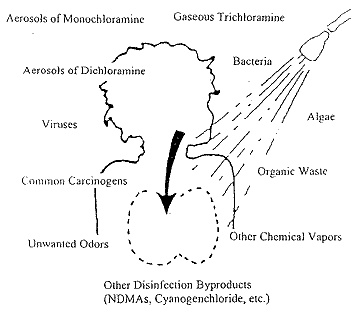
San Francisco Bay Area, California 408 227-5767
"You Get More Toxic Exposure
From Taking A Shower Than From
Drinking The Same Water."
.... Summary statement from a recent study at a major U.S. University and as reported in Science News, vol. 130.

Diagram adapted from the Weekly Newsmagazine of Science, SCIENCE NEWS.From Taking A Shower Than From
Drinking The Same Water."
.... Summary statement from a recent study at a major U.S. University and as reported in Science News, vol. 130.

Chemistry VOL 130 no. 12
Pages 177-192
Toxic showers and baths
In a new study, researcher Julian Andelman, of the University of Pittsburgh
Graduate School of Public Health, the National Academy of Sciences has shown that
volatile chemicals present in many municipal drinking water supplies are especially toxic
to people when they are exposed to them when bathing or showering. ". . .the major health
threat posed by these water pollutants is far more likely to be from their inhalation as air
pollutants in the home, according to preliminary data from a study Andelman and his
colleagues have just reported."
"In the past, he says, inhalation exposure to water pollutants has largely been ignored." His data indicates that hot showers can liberate between 50 to 80 percent of the dissolved chemicals into the air. Emissions from hot baths are half as high. "(One reason, explains Andelman, is that because water droplets dispersed by a shower head have a larger surface-to volume ratio than water streaming into a bath, more of the volatiles can vaporize out)."
It is interesting to note that chloramine actually exists in three forms: monochloramine, dichloramine, and trichloramine. The three forms constantly and rapidly shift from one form to another. "The different volatilities of the chloramines result in substantial differences in the rates of release from water: di- and tri-chloramine are released ~3 and 300 times faster than monochloramine, respectively." (See page 3 of Chemicals in Drinking Water: Chloramine (PDF, 178 KB), by Scottish Centre for Infection and Environmental Health. Alternate source: click here.) These chemicals vaporize easily out of the water that is heated and aerosolized. All three forms are respiratory irritants, with trichloramine being the most toxic.
Andelman points out that.. . "Although showering can be an intense source of residential exposure to water pollutants, . . . it is far from the only important source. Andelman notes that only about 5 of the 50 to 70 gallons of water used daily by the average American goes for showers. Much of the rest is used by dishwashing and laundering. "
"Though actual doses will depend on many factors--especially the level of water contamination--the study does offer clues for limiting exposure. Cold showers can reduce the vaporization of dissolved volatile chemicals by 50 percent, Andelman says. And short showers help, since each doubling in shower time quadruples the dose from accumulating gases. Finally, to limit the spread of released gases into the rest of the home, he suggests closing the bathroom door while bathing and exhausting the room air outdoors."
Science News, Vol. 130 no. 12, pgs. 177-192, cited by CCAC in this report.
"In the past, he says, inhalation exposure to water pollutants has largely been ignored." His data indicates that hot showers can liberate between 50 to 80 percent of the dissolved chemicals into the air. Emissions from hot baths are half as high. "(One reason, explains Andelman, is that because water droplets dispersed by a shower head have a larger surface-to volume ratio than water streaming into a bath, more of the volatiles can vaporize out)."
It is interesting to note that chloramine actually exists in three forms: monochloramine, dichloramine, and trichloramine. The three forms constantly and rapidly shift from one form to another. "The different volatilities of the chloramines result in substantial differences in the rates of release from water: di- and tri-chloramine are released ~3 and 300 times faster than monochloramine, respectively." (See page 3 of Chemicals in Drinking Water: Chloramine (PDF, 178 KB), by Scottish Centre for Infection and Environmental Health. Alternate source: click here.) These chemicals vaporize easily out of the water that is heated and aerosolized. All three forms are respiratory irritants, with trichloramine being the most toxic.
Andelman points out that.. . "Although showering can be an intense source of residential exposure to water pollutants, . . . it is far from the only important source. Andelman notes that only about 5 of the 50 to 70 gallons of water used daily by the average American goes for showers. Much of the rest is used by dishwashing and laundering. "
"Though actual doses will depend on many factors--especially the level of water contamination--the study does offer clues for limiting exposure. Cold showers can reduce the vaporization of dissolved volatile chemicals by 50 percent, Andelman says. And short showers help, since each doubling in shower time quadruples the dose from accumulating gases. Finally, to limit the spread of released gases into the rest of the home, he suggests closing the bathroom door while bathing and exhausting the room air outdoors."
Science News, Vol. 130 no. 12, pgs. 177-192, cited by CCAC in this report.